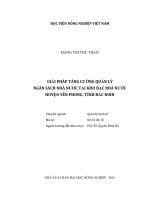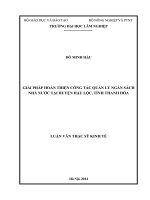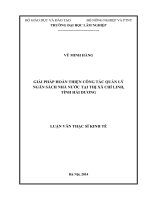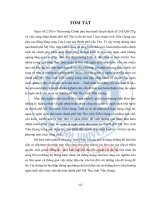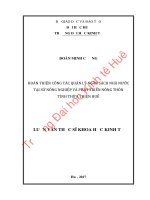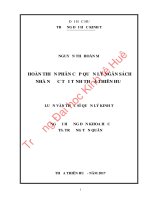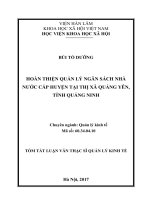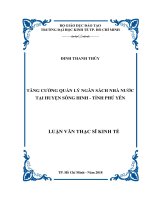Quản lý ngân sách nhà nước tại tỉnh luang prabang nước CHDCND lào TT TIENG ANH
Bạn đang xem bản rút gọn của tài liệu. Xem và tải ngay bản đầy đủ của tài liệu tại đây (281.69 KB, 31 trang )
MINISTRY OF EDUCATION AND TRAINING
MINISTRY OF HOME AFFAIRS
NATIONAL ACADEMY OF PUBLIC ADMINISTRATION
DAYMONE VIRANON
STATE BUDGET MANAGEMENT IN LUANG
PRABANG PROVINCE, LAO PDR
Major: Public Management
Code: 9 34 04 03
SUMMARY OF DOCTORAL DISSERTATION ON
PUBLIC MANAGEMENT
HANOI, 2021
The work was completed at: National Academy of Public Administration
Supervisor:
1. Assoc. Prof. Truong Quoc Chinh
2. Dr. Le Toan Thang
Reviewer 1:
……………………………………………………………
…………………………….……………………………
Reviewer 2:
……………………………………………………………
……………………………..……………………………
Reviewer 3:
……………………………………………………………
……………………………….…………………………
This dissertation will be defended in front of the Academy-level Thesis
Committee
Address: Doctoral thesis defense room - Meeting room…. Building…,
National Academy of Public Administration. No. 77 - Nguyen Chi
Thanh Street - Dong Da District - Hanoi
Time: at ………
The disseration can be found at the National Library of Vietnam or the
library of the National Academy of Public Administration.
INTRODUCTION
1. Reasons for choosing the research topic
Lao PDR is a country with certain development, achieved a
number of achievements, of important socio-economic significance.
However, in the process of implementing the renovation, the state
budget management of Laos is still weak, the local budget is not yet
self-sufficient in revenue for expenditures, so it still has to receive
subsidies from the central budget; The use of the budget tool in
adjusting the macroeconomic targets of the provincial government is
somewhat limited.
Luang Prabang is a province of Lao PDR that is transforming
with the country for socio-economic development. Strengthening the
management of the state budget, renovating the management of
budget revenues and expenditures will create conditions to increase
budget revenue and use the national budget more economically and
effectively; promote local socio-economic development.
In recent years, besides the achievements in local budget
management, Luang Prabang also has some limitations and inadequacies
in state budget management. The annual budget revenue is not enough to
spend, the province must provide a balance subsidy, the issue of
strengthening budget management becomes more and more urgent. Many
agencies participate in the management of the state budget, but the
regulations on the authority to decide the budget are not clear among
agencies, and there are overlaps. The process of state budget management
at provincial level is still heavily formal, and in the process of budget
management, there is still a lack of dynamism and creativity. Some
regulations are still inadequate and have not created favorable conditions
for the province to control its budget... These limitations have a significant
impact on the socio-economic development of the locality, as well as
creating loopholes for budget loss.
1
Meanwhile, the theoretical basis for state budget management
in Lao PDR is relatively “thin”, especially in local state budget
management. Research on the state budget is not lacking, however,
the vast majority of these works are researched from the perspective
of specialized economic, there are very few studies of the state
budget from the perspective of specialized public management.
Among the few state budget research works from a specialized
public management perspective, they focus on decentralization of
state budget management or only go into the management of revenue
or expenditure management, but there is no research on state budget
management at provincial level. Therefore, the theoretical basis for
the provincial state budget is the problem.
From the position and role of the provincial state budget for
local governments, from the current state of state budget
management in Luang Prabang province, there are still many
shortcomings, from the theoretical basis of state budget management
at the provincial level which is still “thin”, therefore, the doctoral
candidate chooses the issue of “State budget management in
Luang Prabang province, Lao PDR” as a research topic for his
doctoral disseratation in Public Management.
2. The purposes and tasks of the dissertation
2.1. The research purposes
On the basis of supplementing and perfecting the theoretical
framework on state budget management; analyzing the reality of
state budget management in Luang Prabang province, Lao PDR,
the dissertation proposes views, directions and solutions to
improve state budget management in Luang Prabang province,
Lao PDR, thereby contributing to promote local socio-economic
development.
2
2.2. The research tasks
- Overview of researched works related to state budget
management.
- Synthesize, supplement and complete the theoretical
framework on state management for the provincial state budget.
- Analysis and assessment of the current state of budget
management in Luang Prabang province.
- From the local situations, from the point of view of the Lao
Party and State, the development direction of the province, the
dissertation proposes a system of solutions.
3. Object and scope of the research
- The research object of the dissertation is state budget
management activities at provincial level.
- The dissertation studies the provincial budget management in
Luang Prabang province from 2015 to 2020 with a vision to 2030.
4. Research methodology
- The dissertation is researched and deployed on the basis of
the dialectical and historical materialism methodology of MarxismLeninism.
- Research methods: analysis, synthesis; inheritance; compare;
statistical.
5. Scientific hypothesis and research questions
5.1. Scientific hypothesis
In fact, the state budget revenue of Luang Prabang is not high,
while the expenditure is quite large. There are many reasons, but the
main reason is that the state budget management is still limited,
leading to the loss or waste of the budget. If Luang Prabang's state
budget management is completed, the province's state budget will be
used more effectively, creating a driving force to promote local socioeconomic development.
3
5.2. Research questions
- What is state budget management at provincial level and
managing according to what contents?
- What factors affect state budget management at provincial
level?
- What lessons can be learned from Luang Prabang province,
Lao PDR from the practice of state budget management at the
provincial level of some other localities?
- What is the current state of Luang Prabang's state budget
management at the provincial level? What are the results and what
are the limitations? The reason why?
- To continue to improve the management of the state budget
at the provincial level, what solutions does Luang Prabang need? On
what basis?
6. New contributions of the doctoral dissertation
- The dissertation contributes to perfecting the theoretical
framework of state budget management at provincial level; draw
some lessons on state budget management and apply it to perfect
budget management of Luang Prabang province, Lao PDR.
- The dissertation has analyzed and described the whole
picture of budget management of Luang Prabang province, Lao
PDR; At the same time, a system of solutions has been proposed
to further improve state budget management in Luang Prabang
province of Lao PDR.
7. Theoretical and practical significances of the dissertation
- The research results of the dissertation will provide scientific
evidence and reliable information on issues related to state budget
management in a locality of Laos. That result has a certain impact on
the state budget management practice in Luang Prabang province,
4
contributing to the good use of local financial resources, improving
the state budget management capacity of the authorities at all levels.
- The dissertation research results are a reference for scientists
to research and learn about the state budget system, the provincial
budget management mechanism in Lao PDR.
Chapter 1
LITERATURE REVIEW OF THE RESEARCH WORKS
RELATED TO STATE BUDGET MANAGEMENT
1.1. Results of research works
Research works refer to issues related to state budget
management, from expenditure to management decentralization. The
works have achieved many results, contributing to providing
innovative solutions, perfecting the state budget management in
order to improve the effectiveness and efficiency of the State's
management role in the state budget.
1.2. Gaps in state budget management need further study
First, the research works only focus on the problem of dividing
the scope of management between the central government and the
local government in the revenue - expenditure tasks, but have not
considered in terms of basis, the division basis associated with the
particularity of each locality.
Second, some issues about the conditions for local authorities
to manage state budget revenues and expenditures have not been
clarified yet.
Third, many works are not completely based on the
perspective of public management such as studying the management
methods and methods of state agencies towards the state budget...
towards the effectiveness and efficiency of local governments, with
Theory of budget management according to outputs, theory of
owners and agents, etc.
5
Fourth, there has not been any research work at the doctoral
dissertation level that has studied in-depth the state budget
management at the provincial level in Luang Prabang province from
an overall perspective.
On the basis of reference and inheritance of research results on
state budget management of previous works, the dissertation topic
sets out the following research directions to be solved:
First, to perfect the theoretical basis for the management of the
state budget from the legal system of the Lao PDR, to clarify the
concepts of state budget and state budget management at the provincial
level based on the provisions of Laos, the necessity, principles and
contents of provincial-level state budget management in localities of the
Lao PDR, associated with the specific characteristics of the country's
institutions and socio-economic situation.
Second, in-depth analysis and assessment of state budget
management in Luang Prabang province based on the gaps indicated.
Third, identify the limitations and shortcomings that still exist
in the management of the state budget of Luang Prabang province,
point out what are the objective causes, what are the causes of poor
management, lack of human resources in the province, what are the
causes of the general management mechanism, due to inadequacies
in legal regulations...
Fourth, the final aim of the dissertation is to propose a system
of feasible, practical and novel solutions to overcome inadequacies in
order to continue to improve state budget management in Luang
Prabang province, Lao PDR.
Conclusion of chapter 1
Through the synthesis, analysis and evaluation of research
works on state budget management, the author has collected results
for the research of the dissertation topic. Research results of previous
6
works have created the basis or suggested for the author's
dissertation topic new ideas and research directions.
Chapter 2
THEORETICAL AND PRACTICAL BASIS FOR
PROVINCIAL-LEVEL STATE BUDGET MANAGEMENT
2.1. General problems about the state budget
2.1.1. The concept of state budget
State budget means all revenues and expenditures of the
State which have been decided by a competent state agency and
implemented within a year to ensure the performance of the
State's functions and tasks.
2.1.2. The characteristics of state budget
- The creation and use of the state budget fund has always
been associated with the economic and political power of the State
and is conducted by the State on the basis of certain laws.
- State budget has always been closely associated with State
ownership and always contains common and public interests.
- State budget is an estimate of revenue and expenditure.
- State budget is a major part of the national financial system.
- State budget is always associated with class character.
2.1.3. The role of state budget
- The state budget is the main tool to directly or indirectly
allocate national financial resources, orient production development,
form a new economic structure, and promote stable and sustainable
economic growth.
- State budget is a tool to regulate the market, stabilize prices
and control inflation.
- State budget is an effective tool of the State to adjust in the
field of income, contributing to solving social problems.
7
- State budget for consolidating and strengthening the power of
the State apparatus, protecting the country and maintaining security.
- State budget inspects national financial activities.
2.1.4. State budget system
The state budget system is understood as the totality of budget
levels that have an organic relationship with each other in the process
of performing the tasks of revenue and expenditure of each budget
level. In Lao PDR, the state budget system basically consists of the
central budget and the local budget.
2.2. Management of state budget at provincial level
2.2.1. The concept and necessity of state budget management
at the provincial level
Provincial-level state budget management is the use of
appropriate methods (administrative, economic, educational, etc.) by
the provincial government to control state revenues and expenditures
already approved by the agency. The state has the authority to decide
and implement it within a year so that the provincial government can
well perform its functions and tasks.
- The provincial state budget ensures the State functions of the
provincial government to perform the functions and tasks prescribed
by law.
- The provincial budget is an important financial resource to
help the provincial government exploit the socio-economic strengths
in the province.
- The provincial budget is a financial tool that helps the superior
state government monitor the activities of the provincial government.
- The provincial budget orients economic sectors to develop
properly, bringing into play the potentials and strengths of the locality.
2.2.2. Targets of state budget management at provincial level
- Total actual expenditure target
8
- Total actual revenue target
- Additional budget for local government target
2.2.3. Contents of state budget management at provincial level
- Management of state budget revenues at the provincial level
- Management of state budget expenditure at the provincial level
- Managing the balance of the state budget at the provincial level
- Supervising, inspecting, auditing and handling violations in
provincial-level state budget management
2.2.4. Factors affecting the management of state budget at
provincial level
- Economic institutions.
- Qualifications of public officials and provincial budget
management organizations.
- Policies to encourage the exploitation of financial resources.
- Level of economic development and income level of people.
2.3. Experience in state budget management of some
provinces at provincial level and reference value for Luang
Prabang, Lao PDR
2.3.1. Experience in state budget management of some
provinces at the provincial level
- Thai Binh province (Vietnam), divides revenues into 2
groups of administrative units, and divides non-state revenue into 2
targets; division of land use levy revenue into 3 types, in addition,
clearly detailing each revenue division in each revenue field... State
budget expenditures are clearly defined for spending on capital
construction investment for socio-economic infrastructure works that
are not able to recover capital. Commune-level budget expenditures
are responsible for spending on transportation, urban construction
managed by the commune level, spending on extension of
9
agriculture, forestry and fishery under the management of the
commune, and activities of grassroots Party organizations.
- In order to well manage the state budget, Bac Ninh province
has streamlined the apparatus, clearly demarcated the functions and
tasks of each agency, unit, and level. To harmonize the expenditure
norm in the total assigned allocation norm, which is required to
achieve the persuasive cost norm of each type of work on the list of
total resources and the sum of all allocated structures.
- Xiangkhouang (Laos) has clearly identified revenue sources
and spending tasks of each budget level; strengthening and
promoting the role of lower-level authorities in the administration
and management of local budgets in the area, the proportion of
budget revenue and expenditure in the province is gradually shifting
towards increasing the proportion of local budgets for subordinates,
and reducing the proportion of local budgets. provincial level.
Besides, the settlement work has gradually come into order with
increasingly improved quality.
- Oudomxay province (Laos), linking the distribution of the state
budget with the mobilization of social resources to meet the
requirements of implementing the province's socio-economic goals in
the medium term. Implement the assignment of full financial autonomy
to non-business units with income. Promote the socialization of nonbusiness activities in the direction of focusing on social tasks, while
mobilizing social resources for development. Implement policies to
encourage economic sectors to participate in social services.
2.3.2. Reference value for provincial budget management of
Luang Prabang, Lao PDR
- Increase the efficiency of budget collection activities of
provincial governments.
10
- Strictly control budget revenues and expenditures, restraining
excessive increase in spending demand; It is necessary to give
importance to expenditures that stimulate private sector investment
and ensure a socially equitable distribution.
- In the decentralization of budget management, it is necessary
to ensure the leading role of the central budget, consider the central
budget as the national budget, operating on a national scale.
- Consider the budget disclosure at all levels.
- Applying information technology in state budget management.
Conclusion of chapter 2
In this chapter, the dissertation has achieved the following
results: overview of general budget issues including concept, role,
characteristics and budget system; clarifying a number of theoretical
issues on state budget management at provincial level; On the basis
of experience in managing state budget at the provincial level of
some provinces, some reference values are drawn for Luang Prabang
province of Lao PDR.
Chapter 3
THE SITUATION OF STATE BUDGET MANAGEMENT IN
LUANG PRABANG PROVINCE, LAO PDR
3.1. Natural, economic and social conditions of Luang
Prabang province - the basis for state budget management
activities at the provincial level
3.1.1. Natural conditions
Luang Prabang Province is a province in the North of Laos,
including 12 districts (cities). Luang Prabang province has an area of
80% of steep rocky mountains, the forest area accounts for 50% of the
province's area. Luang Prabang province is rich in natural resources,
such as coal mines, copper mines, manganese mines, gold mines, etc.
11
3.1.2. Socio-economic situation
The total labor force of Luang Prabang province is 161,023
people (2018), accounting for 46.44% of the province's total
population, of which agricultural workers are 143,858 people,
accounting for 91.5%; industry is 3.7%; services is 4.8%; The rest
are employed in other occupations.
In the period of 2015 - 2019, the economy of Luang Prabang
province has achieved a good and continuous growth rate, with an
average GDP growth rate of 7%. The economic structure has shifted
in line with the trend of gradually increasing the proportion of
agriculture - forestry, industry and service sectors.
Economic structure of key industry groups in the period
2015-2019
(Unit: %)
Agriculture
Industry
Service
2015
59.0
15.9
25.1
2016
58.6
15.5
25.9
2017
56.7
17.0
26.3
2018
54.6
16.3
29.1
2019
50.9
17.4
31.7
Source: Luang Prabang Statistical Yearbook
3.2. The situation of state budget management at the
provincial level in Luang Prabang province
3.2.1. The situation of state budget management agencies at
Luang Prabang province
The provincial state budget management of Luang Prabang
has a system of participating agencies: People's Council, People's
Committee, Department of Planning and Investment, Department of
Finance, Provincial State Treasury, Provincial Tax Department.
12
3.2.2. The situation of state budget revenue management at
provincial level
State budget revenue is an important part in the implementation
of the State budget. Therefore, revenue collection requires compliance
with certain principles. The order of implementation of budget revenue
estimates for different revenues will have different forms. The two
revenues that account for a large proportion in the locality are fees,
charges and revenues from non-business units.
Over the years, the budget revenue targets in the locality have
been continuously increased.
Table of Luang Prabang State Budget Revenue (unit: million kip)
TT
Content
2016
2017
2018
2019
1 Tax collection
Annual tax
2 collection
3 Fee collection
Land tax
4 collection
Earning
expertise and
5 profession
Property
management
6 revenue
Revenue from
management of
state-owned
7 enterprises
Customs
8 collection
9 Local collection
Total
210,511.45
257,701.13 293,487.59 303,358.48
161,475.72
3,452.17
195,840.94 216,246.42 239,642.75
5,570.67 11,222.28 10,582.43
9,674.99
16,515.12
18,735.46
11,566.44
35,908.56
39,774.41
47,283.43
41,566.86
14,402.12
20,009.43
18,642.86
21,135.31
216.60
418.07
549.80
204.09
242.53
225,130.17
661,014.31
187.16
278,128.63 312,680.24 324,697.88
813,958.39 919,035.24 952,754.24
(Source: Luang Prabang Provincial Department of Finance)
13
- Inspecting the implementation of budget revenue estimates:
Prepare a summary table of data on the implementation of
budget revenue in the inspection period. Verify and compare at the
Tax Department, the State Treasury of the province about the total
budget revenue and details of each revenue according to the content
of the estimate or tax. Determine the absolute number and actual
percentage of each indicator; compared with the revenue estimate
assigned by the Provincial People's Committee. As a result of the
inspection at the units, the total budget revenue was 61.1 billion kip,
29.6 billion kip higher than the estimate assigned by the Resolution
of the Provincial People's Council (corresponding to 94.16%).
3.2.3. The situation of state budget expenditure management
at provincial level
After receiving the decision on budget allocation from the
Provincial People's Committee. On the basis of assigned tasks and
functions, based on the plan to use the estimate. The units using the
estimate request the finance authority of the same level to verify the
allocation of recurrent expenditure estimates to the unit. On the basis
of the allocation request of the budget-using unit of the same level,
the finance authority shall verify the unit's assigned estimate and the
direction of the unit's use of the estimate, verify and allocate
recurrent expenditure estimates to budgeting units of the same level.
After receiving the verification of estimate allocation from the
financial agency, the level 1 cost estimate unit shall issue a decision
to hand over the estimate to the affiliated costing unit (if any), and
jointly send it to the finance authority of the same level. Perform
budget allocation into budget management software. Through the
State Treasury of the same level allocating regular funding to the
estimating unit.
14
TT
1
2
3
4
5
6
7
8
Table of Luang Prabang local budget expenditures (unit:
million kip)
Contents
2016
2017
2018
2019
Recurring
558,588.96 640,249.70
656,714.89
640,920.71
expenses
Payroll
385,674.37 416,670.20
420,542.32
392,820.91
expenses
Support
48,419.13
56,701.61
63,359.95
64,144.44
expenses
Expenses to
37,004.04
69,978.22
77,140.73
70,350.02
serve the state
apparatus
Expenses for
13,251.42
16,321.60
17,940.16
17,401.20
regulation and
promotion
Other incurred
1,800.00
1,800.00
13,214.70
12,872.84
expenses
Expenses for
2,689.00
2,790.00
609.74
buying and
renting
properties
Total
69,751.00
75,988.08
64,517.03
82,721.55
investment
expenses
Total
1,117,177.93 1,280,499.41 1,313,429.79 1,281,841.41
expenditure
(Source: Luang Prabang Provincial Department of Finance)
- Inspection are carried out quite often, but the quality of
inspection is not assessed by the number of times of inspection.
Therefore, the unexpected inspection will detect cases of improper
spending and will help prevent wasteful spending and not saving
the state budget. The inspection before state budget expenditure
from the stage of making state budget expenditure estimates is
strictly inspected and approved by the finance agency and the State
15
Treasury according to the regimes, standards and norms prescribed
by the State.
3.2.4. The situation of state budget balance management at
provincial level
The provincial state budget balance of Luang Prabang is shown
by total revenue - total expenditure according to the table below:
Table of provincial balance (unit: million kip)
TT
1
2
Contents
2016
661,014.31
2017
813,958.39
2018
919,035.24
2019
952,754.24
Total revenue
Total
1,117,177.93 1,280,499.41 1,313,429.79 1,281,841.41
expenditure
Revenue -456,163.62 -466,541.02 -394,394.55 -329,087.17
expenditure
balance
(Source: Luang Prabang Provincial Department of Finance)
In general, the state budget balance in Luang Prabang
province, Lao PDR during this period has seen many positive
changes. However, the state budget balance in this period also has
some limitations.
3.2.5. Inspection, examination, supervision and audit of the
state budget at the provincial level
- About the inspection work. The implementation of the
budget revenue and expenditure estimates basically meets the
regulations (the revenue in 2018 reached 132.5% of the plan
assigned by the province; the district budget revenue that was
decentralized reached 146.2 % compared to the plan). Projects which
are prepared, appraised, and compiled economic-technical reports by
the investor; signed contracts, checked and accepted for completed
volumes; economic and technical report dossiers; dossiers of
16
acceptance for payment, dossiers. basic construction completion
documents fully showing the contents in accordance with regulations
on investment and construction. The use of budget and management
of capital construction investment at the units are compared and
verified in accordance with the provisions of law.
However, the financial management, budget and capital
construction investment projects in Luang Prabang province still
have certain shortcomings and limitations such as: Some
expenditures from the reserve source of the budget not the right
nature and content, mainly supplementing regular activities, but not
arranged right from the beginning of the year. Some expenditures for
units are not under the spending tasks of the budget; allocate and use
revenues and land auction sources for some inappropriate contents;
The assignment of estimates to non-business units still has certain
limitations. Some estimate units have not yet provided a source for
salary reform from service revenue as prescribed, paying in excess of
the actual construction volume, and not paying environmental
protection fees for the volume of backfill soil...
- About the audit. According to the audit report, for the
provincial level, the budget expenditure estimates assigned to
districts and cities are even higher than the actual salary fund for
education, training and vocational training and the operating salary
fund of the state management agencies, district-level unions more
than 37 billion kip. The allocation of economic, education, training
and vocational expenditure estimates also uses the budget to pay
wages for contract workers signed by the province (many years ago)
improperly for more than 4.6 billion kip.
Auditing reports at state-owned enterprises in Luang Prabang
showed that enterprises preserved state capital, managed and used
land for the right purposes for production and business, and paid the
17
basic land rent in full and on time. However, the enterprises still
recorded some entries that were not in accordance with regulations, did
not declare income tax for foreign contractors of 639 million kip, and
has not yet paid to the State budget the outstanding amount of
expenditure (incurred before the time of equitization in 2017) more than
2.18 billion kip. Regarding provincial budget expenditure, the allocation
of capital for a number of projects is still spread, the arrangement of
capital plans for a number of land use source projects is not close to the
local reality. The project is in the layout plan of 2018…
3.2.6. The situation of the implementation of the target
3.2.6.1. Total actual revenue target
In the three years 2017, 2018, 2019, the total local budget
revenue of Luang Prabang province exceeded the budget estimate at
the beginning of the year decided by the People's Council, but in
terms of relative numbers, the percentage of excess revenue in 2017,
2018 and 2019 is respectively. 4.21%, 5.81% and 8.56%. Tax
revenue tends to increase steadily. Fees have a sharp increase rate.
Professional income increased and decreased unevenly. 2017
increased, 2018 decreased sharply and 2019 increased. Asset
management revenues also tend to increase, but spiked in 2017.
This fact allows to say that the proportion of revenue from
production and business activities of Luang Prabang province has not
reached the estimate. The total revenue estimate was completed
thanks to a number of unstable and unpredictable revenues such as
fines, confiscation, and money collected from the public land fund
and public land in the district. And these are also very low
sustainability revenues.
3.2.6.2. Total actual expenditure target
Recurring expenditure is an expense that accounts for a very large
proportion of total real expenditure and recurrent expenditure is
18
increasing. The difference between actual expenditure of recurrent
expenditure is not much difference, it has been stable since 2016 until
now. Payroll spending also accounts for a large proportion, however, in
the last 3 years, there has been a decreasing trend. The difference
between the actual expenditure of the salary fund according to the
sinusoidal diagram, increasing and decreasing steadily.
There is a large difference between the actual expenditure of
the state apparatus. In 2016 and 2018; In 2017 and 2019 the
difference is similar. However, the difference between 2016 and
2017 and 2018 and 2019 is much different.
3.2.6.3. Target for additional budget for local government
According to the results of the global survey on the Open
Budget Survey 2020, Laos' budget disclosure and transparency score
has increased sharply compared to previous evaluation periods,
reaching 48/100 points for the public sector pillar. budget
declaration, up 21 points compared to 2019; 09/100 points for pillars.
Public participation, up 3 points compared to 2019; 64/100 points for
the Monitoring pillar, up 2 points compared to 2019. Lao PDR
ranked 97th out of 117 countries, up 4 places compared to 2019.
According to the OBS 2020 ranking with the three pillars
mentioned above, Lao PDR is assessed to have made remarkable
efforts and progress in terms of budget transparency.
3.3. Overall assessment of provincial budget management
in Luang Prabang province, Lao PDR
3.3.1. Results
- Regarding state budget revenue. The structure of state budget
revenue has been gradually improved, the proportion of domestic
revenue in the total balance of state budget revenue is high, in the
period 2015 - 2019 it will reach an average of 89.9%. Total state
budget revenue in 2019 reached 390,650 billion kip, equal to 100.2%
19
of the estimate (over 750 billion kip). Domestic revenue reached
102.9% of the estimate (exceeding 6,650 billion kip). Revenue from
tourism is estimated at 91.1% of the estimate (down 5,700 billion
kip). Balanced budget revenue from import-export activities reached
98.6% of the estimate (down 1,200 billion kip); Aid collection is
estimated at 6,000 billion kip (an increase of 1,000 billion kip
compared to the estimate).
- Regarding state budget expenditure. The process of
organizing and implementing expenditure estimates in the period of
2015-2019 has ensured that all spending tasks according to the
assigned estimates, in general, the estimating units that have
managed, operated, and used the budget have thoroughly grasped the
principles of thrift, efficiency, and anti-waste, meeting the tasks of
local socio-economic development, especially ensuring timely
funding for key and urgent tasks that arise outside the estimate.
- Regarding the state budget balance. Balancing the results of
budget revenue and expenditure in Luang Prabang province from
2015 to 2019 has reflected the province's socio-economic growth,
increased accumulation from within the economy into the budget.
With different characteristics of revenue sources, the revenue
decentralization is also different, the source of revenue accounting
for a large proportion is revenue from central state-owned
enterprises, local state-owned enterprises, public tax collection, nonstate trade, etc., which are focused on revenue collection. Provincial
policies meet the goals and tasks of socio-economic development of
the province. The structure of state budget expenditure has gradually
changed in a positive direction. Domestic revenue is sufficient for
recurrent expenditure. Although there is an overspending, the major
expenditures are capital construction investment and recurrent
expenditure, in which recurrent expenditure accounts for the largest
20
proportion. The state budget fund is not appropriated, ensuring the
solvency of the State; strictly control the spending of the units using
the budget funds allocated through the State Treasury. Timely and
accurate information on revenue and expenditure of budget funds for
budget managers at all levels, ensuring accurate budget management.
- In recent years, more attention has been paid to inspection,
examination, supervision and audit. Inspectors and State Auditors are
constantly supplementing their forces, improving their quality and
working capacity, so the quality of inspection and audit is better.
This contributes to limiting the negative in state budget management
in the locality.
3.3.2. Some limitations and shortcomings
- State budget revenue loss still occurs. Annual administrative
expenses are spent in excess of the assigned norms on one payroll.
- Regarding the state budget balance management, tax reform
still has many shortcomings, the tax system is overlapping and
complicated, causing difficulties for tax collection and management;
Borrowing to cover the state budget deficit only focuses on
addressing spending needs... Budget spending is still scattered and
spread; efficiency of budget expenditure (both capital construction
and recurrent expenditure) is still low and has not focused on output
results. The opening of budget accounting books is not in accordance
with regulations, especially in the field of public property and
accounting in administrative and non-business units.
- The work of inspection, examination and audit has not
brought high efficiency, has not been able to combine inspection
with effective analysis of the use of recurrent expenditures to advise
measures to improve the efficiency of management and use. budget.
The expenditure control of the State Treasury is still heavy with
administrative procedures.
21
3.3.3. Causes of limitations and shortcomings
- Some legal provisions have not been completed, mechanisms
and policies of the State are still entangled due to inadequacies and
inconsistencies.
- Rigid application of the traditional budgeting model.
- The capacity and level of management and administration of
the state budget from administrative agencies to state budget-using
units still have many shortcomings and limitations.
- The propaganda of the State budget law and related
documents has not been sharp and has not achieved the set goals.
- State budget revenue is not stable, state budget expenditure
may increase because the country is entering the period of
international economic integration.
- Inspection, examination and supervision have not been paid
due attention, when detecting errors, clarifying organizational and
individual responsibilities and handling are not strictly.
- The province's informatics infrastructure is limited and outdated.
Conclusion of chapter 3
This chapter has assessed the current state of state budget
management of Luang Prabang province over the past time, pointed
out some shortcomings and limitations in the state budget
management of the province and the causes of these limitations. This
will be the basis for proposing solutions to improve the state budget
management of Luang Prabang province in the coming time.
Chapter 4
PERSPECTIVES AND SOLUTIONS TO IMPROVE STATE
BUDGET MANAGEMENT IN LUANG PRABANG
PROVINCE, LAO PDR
4.1. The perspective on improving state budget
management in Luang Prabang province
22
4.1.1. Socio-economic development orientation of Luang
Prabang province to 2030
Promote economic development at a fast and sustainable pace,
promote and effectively exploit land, forests, hydropower potential
and tourism advantages, and increase attraction of capital from
outside. Step by step shifting the economic structure towards
prioritizing in-depth investment, developing advantageous
manufacturing industries, creating breakthroughs for development,
making great contributions to the overall growth of the economy.
Synchronous development of infrastructure. Synchronously combine
production with development of economic and social infrastructure.
4.1.2. Perspective on improving state budget management in
Luang Prabang province
- Management of state budget according to results.
- Strictly implement documents on state budget.
- Restructure the state budget in the direction of clearly identifying
revenue sources and spending tasks of the provincial state budget.
- Innovating and improving the efficiency of state budget
management in the locality.
- Well implement the distribution and use of state budget capital.
4.1.3. Objectives of state budget management at the
provincial level of Luang Prabang
- To ensure fiscal discipline.
- To allocate state budget effectively.
- To ensure effective local budget revenue and expenditure.
- To prevent acts of violating the law on state budget.
4.2. Solutions to improve state budget management in
Luang Prabang province
4.2.1. Promote decentralization in state budget management
Eliminate the inclusion of the superior budget for the
23
